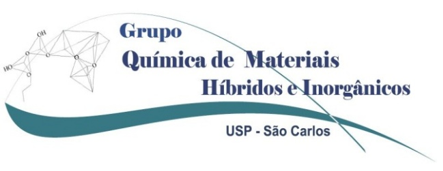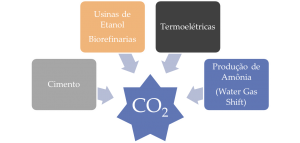O entendimento do processo de formação de ligação química, da microestrutura e sua relação com as propriedades macroscópicas se fundamenta como uma das bases da química e da ciência e engenharia dos materiais, e cada vez vem aumentando a demanda por novos produtos com alto desempenho, durabilidade, baixo custo e fácil processabilidade.
O Grupo de Química de Materiais Híbridos e Inorgânicos (GQMatHI) foi formado em 2013 e é coordenado pelo Prof. Dr. Ubirajara Pereira Rodrigues Filho e Prof. Dr. Hidetake Imasato, ambos do Instituto de Química de São Carlos (IQSC). É um grupo interdisciplinar com pesquisas de caráter fundamental e aplicado que englobam conhecimentos tanto de Química quanto de Ciência e Engenharia de Materiais. Esses conhecimentos envolvem química de sólidos e de superfície, síntese e processamento de polímeros orgânicos e inorgânicos, blendas e compósitos (especialmente materiais híbridos), sol-gel, fotoquímica, fotocatálise, eletroquímica, entre outros.
Oficialmente o GQMatHI apresenta uma historia bastante recente, porém, suas contribuições no desenvolvimento de materiais já vem de alguns anos. Entre outras coisas, já foram desenvolvidos sob orientação do Prof. Ubirajara membranas para células a combustível para meio ácido e básico, filmes fotocrômicos, filmes fotoativos e síntese envolvendo CO2.
_______________________________________
The GQMathi aims to study, develop and apply nanostrucutred materials, nanoparticles, and hybrid organic-inorganic materials as well as materials´ surface modification procedures.
The Group start its activity inside the Inorganic and Analytical Chemistry Group of the Institute of Chemistry of Sao Carlos, USP, back on August 1998, At that time, it was fully dedicated to design of semiconductors surfaces (silicon and germanium) with coordination and metalorganic compounds modeling catalysts and sensor surfaces. At the same time we start to develop nanocomposites for acid catalysts and photochromic sensors based on cellulose esters and polyoxometallate chemistry as well as Sio2 and ZrO2 doped cellulose ester membranes, which was my original PhD subject.
On 2001 we start a new research line on archaeometry of ancient ceramics with prof Jose Luis Peixoto from UFMS at Corumbá, MS, Brazil.
On 2005 we start to work with Layer-by-layer films with prof Osvaldo N Oliveira Jr, IFSC/USP, aiming biosensors and witth prof Andre A Pasa (DF/UFSC),prof Jose S Acuña (UFABC), and Dr Philippe Alongue, Jean Noel Chazaviel and Catherine H de Villeneuve, PMS- Ecole Polytechnique at Palaiseau (France), Germano Tremiliosi Filho (IQSC) and Ana Maria Rego (Universidade de Lisboa) on chemical sensors.
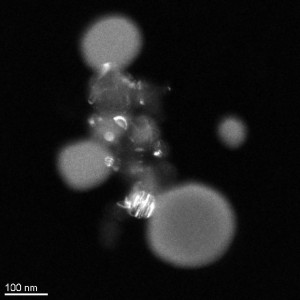
Fisrt Dark-Field Transmission Electron image of the TiO2@phosphotungstic acid in a LBL Cellulose Phosphate film. The bright spheres are anatase particles, and the darkest ones are the polyoxometllate nanoparticles. Study published at Applied Surface Science 277 (2013) 111– 120
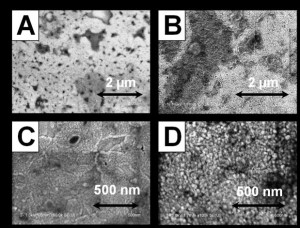
AFM image of the PDMS_PAH LBL Films with HPW used as chemical sensors for triazines (melamine and atrazine).
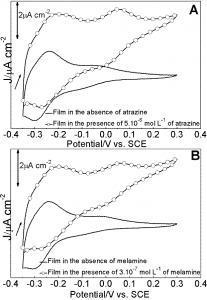
Cyclic Voltammetry of ITO/PDMS/PAH/HPW LBL films showing their electrochemical response in absennce and presence of triazines such as melamine and atrazine.Study published at RSC Adv., 2014,4, 29612-29621. DOI: 10.1039/C4RA01468E,
On 2007 we decide to study again with sol-gel chemistry, since I´ve worked with this process on my PhD thesis. The main target was develop new photochromic materials for smart widows, photosensitive lenses and UV personal sensors.

Cartoon representing the bulk structure of hybrid photochromic ormosils. Photochromic Response of the Hybrid Ormosil with different doses of UV.
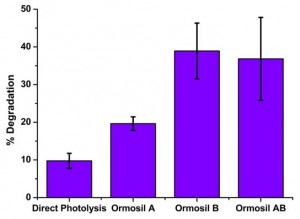
Photodegradation of Methyl Violet using a flat layer of Hybrid Ormosil. Study published at the Journal of Sol-Gel Science and Technology http://link.springer.com/article/10.1007/s10971-013-3018-5.
About the same time we introduce the research on CO2 mitigation through CO2 use as a raw material on polymer and later on hybrid materials. The research start with the study of CO2 fixation by their reaction with epoxide groups as well as in collaboration with prof Douglas W Franco (IQSC) and prof Eduardo R Pérez (UNESP) the electrochemical conversion of CO2 and chemical conversion by using guanidines as catalysts. Th first research approach resulted on the MSc Thesis of José Humeberto Lopes under our guidance and later with the PHD thesis of Rodrigo Biscaro Nogueira under guidance of prof Germano Tremiliosi Filho. Actualy, Kelen M Rossi de Aguiar and Daniel F Leite are working in this subject which is part of the Brazilian-German initiative called ProBral I (funded by CAPES and DAAD).

Example of CO2 use to produce raw material for polymer synthesis. Study published at RSC Advances 2014,4, 24334-24343, DOI: 10.1039/C4RA03846K
More recently we have been involved on synthesis of photocatalyst sub-micron particles as well as ormosil films with enhanced activity toward dyes.
International Collaboration among Brazilian researchers (IQSC-USP; FOP-UNICAMP; DQ-UESPi) leaded by GQMATHI and German Researchers from Fraunhofer Institute and Technical University of Dresden is highlighted in interview to Deutsches Wissenschafts- und Innovationshaus São Paulo (DWIH-SP)/ Centro Alemão de Ciência e Inovação São Paulo (DWIH-SP) (Interview).

